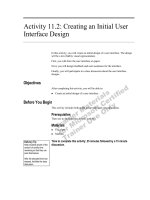Creating flat design websites
Bạn đang xem bản rút gọn của tài liệu. Xem và tải ngay bản đầy đủ của tài liệu tại đây (3.83 MB, 112 trang )
www.it-ebooks.info
Creating Flat Design Websites
Design and develop your own flat design
websites in HTML
António Pratas
BIRMINGHAM - MUMBAI
www.it-ebooks.info
Creating Flat Design Websites
Copyright © 2014 Packt Publishing
All rights reserved. No part of this book may be reproduced, stored in a retrieval
system, or transmitted in any form or by any means, without the prior written
permission of the publisher, except in the case of brief quotations embedded in
critical articles or reviews.
Every effort has been made in the preparation of this book to ensure the accuracy
of the information presented. However, the information contained in this book is
sold without warranty, either express or implied. Neither the author, nor Packt
Publishing, and its dealers and distributors will be held liable for any damages
caused or alleged to be caused directly or indirectly by this book.
Packt Publishing has endeavored to provide trademark information about all of the
companies and products mentioned in this book by the appropriate use of capitals.
However, Packt Publishing cannot guarantee the accuracy of this information.
First published: April 2014
Production Reference: 1160414
Published by Packt Publishing Ltd.
Livery Place
35 Livery Street
Birmingham B3 2PB, UK.
ISBN 978-1-78398-004-8
www.packtpub.com
Cover Image by Faiz Fattohi ()
www.it-ebooks.info
Credits
Author
Project Coordinators
António Pratas
Melita Lobo
Akash Poojary
Reviewers
Eddy Borja
Proofreader
Pedro Piñera Buendia
Simran Bhogal
Emrullah Lüleci
Indexer
Commissioning Editor
Priya Subramani
Rebecca Youé
Production Coordinator
Arvindkumar Gupta
Acquisition Editor
Rebecca Youé
Cover Work
Content Development Editor
Arvindkumar Gupta
Priyanka Shah
Technical Editors
Mrunal Chavan
Edwin Moses
Copy Editors
Sayanee Mukherjee
Karuna Narayanan
Alfida Paiva
Adithi Shetty
www.it-ebooks.info
About the Author
António Pratas is a Portuguese designer living in London. He has an MSc
in Multimedia Design and has been working as a designer since 2005. He has
worked with advertising agencies and in design ateliers, including Euro RSCG
(now Havas), Bürocratik, and Universidade de Coimbra. He has also co-founded
a small design atelier and a web startup. He previously wrote articles for
designmodo.com, webdesignerdepot.com, and awwwards.com.
www.it-ebooks.info
Acknowledgment
I always looked up to good and famous designers/authors as if they had the answers
to all design problems. However, eventually I found out that design is not about the
answers, it's about asking the right questions, and even these great designers are,
in the end, only humans. There's no correct way or formula on how to do things or
solve problems, it's about choosing a path and trusting you're doing what is best for
each problem you're faced with.
This book would not have been possible without the support of my lovely girlfriend
Márcia Gaudêncio. Thank you for all your help and patience, and for all the meals
you cooked and chores you've done that should've been my responsibility, while
I was busy with my laptop for hours on end.
I'd also like to thank Rebecca Youé for offering me the chance of writing my first
book, as well as the Packt Publishing team and reviewers for their great work in
reviewing and helping out over and over again.
Last but (definitely) not least, I'd like to thank my father, António Redondo Pratas,
and my mother, Leopoldina Correia for giving me all they could ever give me,
making me everything that I am today, and teaching me all that I know and do.
You can't find these things in any book. Obrigado!
www.it-ebooks.info
About the Reviewers
Eddy Borja has witnessed the evolution of websites from their static Web 1.0
beginnings to the modern designs that we have now, throughout his life. His first
exposure to web design and development began during his teenage years, and he
has been involved in the creation of web and mobile apps ever since. He has been a
consultant for many startups and a co-founder of a software development shop that
builds mobile apps for its clients.
As always, I'd like to thank my parents and my family for their
never-ending support, and my love, Karla Salazar, for her support
and encouragement.
Pedro Piñera Buendia is an Electronics and Telecommunication engineer from
Spain. He started working as a mobile developer in 2010, and since then, he has been
involved in developing applications that are related to health and entertainment. He
is currently working as an iOS developer for Redbooth, a platform to help companies
manage their projects (through tasks, notes, conversations, and so on).
I would like to thank my girlfriend and Merengue (my dog) for
waiting for me while I was helping the author review this book.
www.it-ebooks.info
Emrullah Lüleci is an entrepreneur, a software engineer, and a UX designer. He
has been developing cloud-based Android and web applications. He believes in the
power of open source. Thus, he owns several open source projects and contributes
to many others. Even though his background is based on programming, he is
passionate about designing and creating unique interfaces, which are mainly flat.
He is also a member of several communities and delivers speeches about mobile
app designs and their development. Emrullah is the founder of CengaLabs, which
focuses on developing mobile applications and sharing all the new tools that are
created for the projects in open source.
www.it-ebooks.info
www.PacktPub.com
Support files, eBooks, discount offers, and more
You might want to visit www.PacktPub.com for support files and downloads related
to your book.
Did you know that Packt offers eBook versions of every book published, with PDF
and ePub files available? You can upgrade to the eBook version at www.PacktPub.
com and as a print book customer, you are entitled to a discount on the eBook copy.
Get in touch with us at for more details.
At www.PacktPub.com, you can also read a collection of free technical articles, sign
up for a range of free newsletters and receive exclusive discounts and offers on Packt
books and eBooks.
TM
Do you need instant solutions to your IT questions? PacktLib is Packt's online
digital book library. Here, you can access, read and search across Packt's entire
library of books.
Why subscribe?
• Fully searchable across every book published by Packt
• Copy and paste, print and bookmark content
• On demand and accessible via web browser
Free access for Packt account holders
If you have an account with Packt at www.PacktPub.com, you can use this to access
PacktLib today and view nine entirely free books. Simply use your login credentials
for immediate access.
www.it-ebooks.info
Table of Contents
Preface1
Chapter 1: What is Flat Design?
5
Defining flat design
5
History and evolution
6
Skeuomorphic versus flat
7
Exercise 1 – the skeuomorphic and flat buttons
8
The use of flat in the real world
15
Summary16
Chapter 2: Designing in Flat
17
Chapter 3: Creating a Flat and Usable Interface
35
Design style
17
Working with limitations
18
Flat is not always the answer
19
Lose your "crutches"
20
Photos or illustration?
21
Respecting the grid
23
Focusing on typography
26
Flat colors
27
Inspiration and references
29
Summary33
Understanding web usability
The importance of web usability
Achieving a good balance
Web forms usability
Creating a web form with regular browser styles
Recreating the form with flat style
Refining the form's usability
www.it-ebooks.info
35
37
38
43
44
45
47
Table of Contents
Flat readability
48
Summary51
Chapter 4: Designing Your Own Flat Website
53
Chapter 5: Developing Your Site
65
Chapter 6: Creating Your Own Flat UI Kit
85
Planning your work
53
Defining your sections
54
Start designing your page
54
Using the Designmodo.com Flat UI
56
Designing in Photoshop
57
Summary64
Creating our folder tree
65
Prepping our images
66
Developing our page
68
Styling our page with CSS
76
Using jQuery for navigation
83
Summary84
Designing your components
85
Exporting and coding
88
Documentation is key
92
Summary93
Index95
[ ii ]
www.it-ebooks.info
Preface
Flat design is a digital style of design that has been one of the biggest trends in recent
years in web and user interface design. It is famous for its extremely minimalistic
style. It has appeared at a time when skeuomorphic, a style of creating realistic
interfaces, was considered to be the biggest and most famous trend, making this a
really rough and extreme transition for both users and designers.
Creating Flat Design Websites will explain the story of flat design since its early roots
to the present day, while also showing you some of the most famous examples and
explaining how to design and implement your own flat design website in a practical
and easy way.
What this book covers
Chapter 1, What is Flat Design?, explains what flat design is, its history since the
introduction of the international typographic style, and how it has evolved over the
years. We will also understand what brands helped bring the flat design to light and
how this style became more evident as a trend for more brands and interfaces, such
as the recently released iOS 7 from Apple.
Chapter 2, Designing in Flat, covers how to design in flat and what are the most
important things that the designer should have in mind while designing. It will focus
on the importance of typography, alignment, and creating a layout by always using a
clear, invisible grid and creating more predictable layouts.
Chapter 3, Creating a Flat and Usable Interface, shows why you should focus on web
usability and how important it is for the good functioning of flat design websites.
The main focus is to avoid any kind of damage to the interface, its navigation and
readability to exemplify this, we will create some tests and visual exercises.
www.it-ebooks.info
Preface
Chapter 4, Designing Your Own Flat Website, will show you, step-by-step, how to
design your single page flat website. We will cover the entire journey from planning
visual sections to deciding on layout and navigation, up to the final pixels.
Chapter 5, Developing Your Site, will explain how to develop the page designed in the
previous chapter using Designmodo flat UI Bootstrap components. We will cover
how to code the basic static page, as well as jQuery transitions and CSS3 effects.
Chapter 6, Creating Your Own Flat UI Kit, will go over the creation of your own kit
while reviewing all the work that you have done. We will see how to organize our
images, styles, and effects, and save them for future usage as a personal Flat UI kit.
What you need for this book
Throughout this book, we will be creating a design of a web page and develop
some code, specifically HTML, CSS, and JavaScript (with the help of jQuery).
For the design, we will be using Photoshop, and any version from CS4 onwards
will suffice. For the code, we will require a code editor such as Sublime Text,
which may be downloaded and evaluated for free from http://sublimetext.
com; it's a great piece of software. You can also use any other code editor of your
preference, such as Notepad++ for Windows ( />Coda ( Linux, or Espresso ( />espresso/) for Mac.
Who this book is for
This book is for designers and developers who are interested in creating websites.
Ideally, you should have some prior knowledge of design notions, but it is essential
to know how to use Photoshop at a beginner/medium level. This is also written for
designers who already have some knowledge on frontend development, as we will
develop a website using HTML, CSS, and JavaScript (with the help of jQuery).
Conventions
In this book, you will find a number of styles of text that distinguish between
different kinds of information. Here are some examples of these styles, and an
explanation of their meaning.
Code words in text, database table names, folder names, filenames, file extensions,
pathnames, dummy URLs, user input, and Twitter handles are shown as follows:
"We will now create the styles for our <body> element."
[2]
www.it-ebooks.info
Preface
A block of code is set as follows:
<!DOCTYPE html>
<html lang="en">
<head>
</head>
<body>
<button class="btn">Click Here</button>
</body>
</html>
New terms and important words are shown in bold. Words that you see on the
screen, in menus or dialog boxes for example, appear in the text like this: "Clicking
the Next button moves you to the next screen."
Warnings or important notes appear in a box like this.
Tips and tricks appear like this.
Reader feedback
Feedback from our readers is always welcome. Let us know what you think about
this book—what you liked or may have disliked. Reader feedback is important for
us to develop titles that you really get the most out of.
To send us general feedback, simply send an e-mail to ,
and mention the book title via the subject of your message.
If there is a topic that you have expertise in and you are interested in either writing
or contributing to a book, see our author guide on www.packtpub.com/authors.
Customer support
Now that you are the proud owner of a Packt book, we have a number of things to
help you to get the most from your purchase.
[3]
www.it-ebooks.info
Preface
Downloading the example code
You can download the example code files for all Packt books you have purchased
from your account at . If you purchased this book
elsewhere, you can visit and register to
have the files e-mailed directly to you.
Errata
Although we have taken every care to ensure the accuracy of our content, mistakes do
happen. If you find a mistake in one of our books—maybe a mistake in the text or the
code—we would be grateful if you would report this to us. By doing so, you can save
other readers from frustration and help us improve subsequent versions of this book.
If you find any errata, please report them by visiting />submit-errata, selecting your book, clicking on the errata submission form link,
and entering the details of your errata. Once your errata are verified, your submission
will be accepted and the errata will be uploaded on our website, or added to any list
of existing errata, under the Errata section of that title. Any existing errata can be
viewed by selecting your title from />
Piracy
Piracy of copyright material on the Internet is an ongoing problem across all media.
At Packt, we take the protection of our copyright and licenses very seriously. If you
come across any illegal copies of our works, in any form, on the Internet, please
provide us with the location address or website name immediately so that we
can pursue a remedy.
Please contact us at with a link to the suspected
pirated material.
We appreciate your help in protecting our authors, and our ability to bring you
valuable content.
Questions
You can contact us at if you are having a problem with
any aspect of the book, and we will do our best to address it.
[4]
www.it-ebooks.info
What is Flat Design?
In this chapter, what flat design is and how this style came to be will be explained.
We will cover its predecessors in graphic design since 1950, moving on to how
important skeuomorphic design was in the process of making flat design one
of the biggest trends in digital design in the last few years.
We will also learn what the current status of flat design is, how it has been adopted
by some of the biggest brands in the market, and how we interact everyday with
interfaces designed in flat design. There's also a simple exercise to help you understand
how to build a skeuomorphic element and its flat counterpart, to better clarify the
differences between skeuomorphic and flat design.
Defining flat design
Flat design is a digital design style that was one of the most discussed trends
throughout 2013. It is characterized by a really minimalistic look, focused on
removing all extra elements and effects from a design, such as bevels, shadows,
lighting effects, depth, texture, and every element that creates and gives an extra
dimension to these elements.
This kind of treatment results in creating a very simple and clean look that seems
visually flat on the screen, by using white space, bright colors, and simple lines
as layout elements. Flat design, as a style, rose quickly to fame and to mass use
because of its impactful look but surprisingly simple approach. It started to gather a
big fan base and supporters of the style, because most people saw in flat design an
opportunity for them to be able to create a simple and good looking web page.
It was undoubtedly one of the most discussed topics in design during 2013, and as
there were many supporters, there were also a large number of people opposed to
such a style and against the importance and discussion of it.
www.it-ebooks.info
What is Flat Design?
Also, one of the biggest reasons why flat design was so impactful in the community
was because of its timing. Flat design came in a time when skeuomorphic design
was one of the most famous and used styles in digital design and interfaces. They
contrasted in such a significant way that it was indeed a really rough and extreme
transition for users of these apps as well as for designers that needed to switch
their design style to accommodate the users' wishes and expectations. And what is
skeuomorphic design, you say?
History and evolution
Flat design as a digital design trend and name surfaced on the web around 2012. As
a response and alternative to skeuomorphic designs, the first adopters got a lot of
attention because it was considered a risk to go down a path of creating such simple
and clear layouts, opposed to the complex and heavy ones being created at the time.
This shift of trends is something that always happened, as history shows. Fashion
and style are cyclic, and in this day and age where everything is digital, these cycles
tend to be even shorter and changes can happen quicker than ever.
To truly find the first origins of flat, we need to go back to 1950, with the
development of the International Typographic Style (or the Swiss Style). This style
was also focused on creating a clean, readable design in contrast to the complex
illustrations, textures, and photos used in printed posters at the time. It was also
when Akzidenz-Grotesk, the first version of the typeface that would eventually
become Helvetica, started to be used more often, which gave a newfound strength
and focus on sans-serif typography. Typography was one of the big focus points of
the posters of the Swiss Style, specifically big sans-serif type, thus creating a really
impactful message. We can say that this is historically the first form of flat design.
Some decades later, already in the digital spectrum, Microsoft was one of those
responsible for pushing this kind of minimalistic look forward with the launch of
the Zune music player in 2006. Even though the device in itself wasn't a commercial
success, its interface was revolutionary. The focus on thin and big typography, and
its clear and minimalistic approach to its navigation and iconography, was one of the
roots for today's Microsoft interfaces redesign, which can still be found on the strongly
typographic menus presented on the Windows Phone. Zune also influenced other
products, such as the Xbox 360 dashboard and Windows 8. The Windows 8 interface,
known by the code name Metro UI, was also one of the biggest interface overhauls that
emphasized the flat design style. It was a great change of look for Microsoft Windows
and a really bold one that generated a lot of appraisal by the design community and
influenced a lot of websites that try to replicate the squared layout up to this day. The
following screenshot shows the use of flat design in Metro UI:
[6]
www.it-ebooks.info
Chapter 1
But getting back to the definition of flat design, this as a term and as a style was
defined by designers who wrote about this subject. One of them, Allan Grinshtein,
from LayerVault—a version control for designers—wrote in his post The Flat Design
Era ( how he believes that elegant interfaces are ones that have the most impact with
the fewest elements. This, along with the success and great feedback on the LayerVault
flat design interface, reinforced the notion that a very minimalistic interface can be
thought out to be usable and achieve great success among an application's user base.
At this time, and with the success of the first bold designers, the community followed
and adhered to this style, creating an enormous number of design proposals and
applications following the flat design aesthetic.
Skeuomorphic versus flat
Skeuomorphic design, also known as realism, is a style that was very much used
during 2012 and 2013, and it consists of creating visual elements that represent
their original, physical counterpart.
Skeuomorphism is defined as an element of design or structure that serves little or
no purpose in the artifact fashioned from the new material but was essential to the
object made from the original material (courtesy: Wikipedia—ipedia.
org/wiki/Skeuomorph).
[7]
www.it-ebooks.info
What is Flat Design?
Apple created several skeuomorphic interfaces for their desktop and mobile apps;
apps such as iCal, iBooks, Find My Friends, Podcast apps, and several others.
This kind of interface was both loved and hated among the design community and
users. It was a style that focused a lot on the detail and texture, making the interface
heavier and often more complex, but interesting because of the clear connection to
the real objects depicted here. It was an enjoyable and rich experience for the user
due to the high detail and interaction that a skeuomorphic interface presented, which
served to attract the eye to the detail and care put into these designs; for example, the
page flip in iBooks, visually representing the swipe of a page as in a traditional book.
But this style also had its downsides.
Besides being a harsh transition from the traditional interfaces (as in the case of Apple,
in which it meant coming from its famous glassy and clean looking Aqua interface),
several skeuomorphic applications on the desktop didn't seem to fit in the overall OS
look. Apart from stylistic preferences and incoherent looks, skeuomorphic design is
also a bad design choice because the style in itself is a limitation to innovation. By
replicating the traditional and analogical designs, the designer doesn't have the option
or the freedom to imagine, create, and design new interfaces and interactions with
the user. Flat design, being the extremely simple and clear style that it is, gives all
the freedom to the designer by ignoring any kind of limitations and effects. But both
styles have a place and time to be used, and skeuomorphic is great for applications
such as Propellerheads that are directly replacing hardware, such as audio mixers.
Using these kinds of interfaces makes it easier for new users to learn how to use the
real hardware counterpart, while at the same time previous users of the hardware will
already know how to use the interface with ease.
Regardless of the style, a good designer must be ready to create an interface that is
adapted to the needs of the user and the market. To exemplify this and to better learn
the basic differences between flat and skeuomorphic, let's do a quick exercise.
Exercise 1 – the skeuomorphic and flat
buttons
In this exercise, we'll create a simple call to an action button, the copy of Buy Now.
We'll create this element twice; first we'll take a look at the skeuomorphic approach
by creating a realistic looking button with texture, shadow, and depth. Next, we will
simply convert it to its flat counterpart by removing all those extra elements and
adapting it to a minimalistic style.
[8]
www.it-ebooks.info
Chapter 1
You should have all the materials you'll need for this exercise. We will use the
typeface Lato, also available for free on Google Fonts, and the image wood.jpg for
the texture on the skeuomorphic button. We'll just need Photoshop for this exercise,
so let's open it up and use the following steps:
1. Create a new Photoshop document with 800 x 600 px. This is where we will
create our buttons.
2. Let's start by creating the skeuomorphic one. We start by creating a rectangle
with the rounded rectangle tool, with a radius of 20 px. This will be the face
of our button. To make it easier to visualize the element while we create it,
let's make it gray (#a2a2a2).
3. Now that we have our button face created, let's give some depth to this button.
Just duplicate the layer (command + J on Mac or Ctrl + J on Windows) and pull
it down to 10 or 15 px, whichever you prefer. Let's make this new rectangle a
darker shade of gray (#393939) and make sure that this layer is below the face
layer. You should now have a simple gray button with some depth. The side
layer simulates the depth of the button by being pulled down for just a couple
of pixels, and since we made it darker, it resembles a shadow.
[9]
www.it-ebooks.info
What is Flat Design?
4. Now for the call to action. Create a textbox on top of the button face, set
its width to that of the button, and center the text. In there, write Buy Now,
and set the text to Lato, weight to Black, and size to 50 pt. Center it vertically
just by looking at the screen, until you find that it sits correctly in the center
of the button.
5. Now to make this button really skeuomorphic, let's get our image wood.
jpg, and let's use it as our texture. Create a new layer named wood-face and
make sure it's above our face layer. Now to define the layer as a texture and
use our button as a mask, we're going to right-click on the layer and click on
Create clipping mask. This will mask our texture to overlay the button face.
6. For the side texture, duplicate the wood-face layer, rename it to wood-side
and repeat the preceding instructions for the side layer. After that, and to
have a different look, move the wood-face layer around and look for a good
area of the texture to use on the side, ideally something with some up strips
to make it look more realistic.
[ 10 ]
www.it-ebooks.info
Chapter 1
7. To finish the side, create a new layer style in the side layer, gradient
overlay, and make a gradient from black to transparent and change the
settings as shown in the following screenshot. This will make a shadow
effect on top of the wood, making it look a lot better.
8. To finish our skeuomorphic button, let's go back to the text and define the
color as #7b3201 (or another shade of brown; try to pick from the button and
make it slightly darker until you find that it looks good), so that it looks like
the text is carved in the wood.
[ 11 ]
www.it-ebooks.info
What is Flat Design?
9. The last touch will be to add an Inner Shadow layer style in the text with
the settings shown. Group all the layers and name it Skeuomorphic and
we're done.
And now we have our skeuomorphic button. It's a really simple way of
doing it but we recreated the look of a button made out of wood just by
using shapes, texture, and some layer styles.
Now for our flat version:
1. Duplicate the group we just created and name it flat. Move it to the other
half of the workspace.
2. Delete the following layers: wood-face, wood-side, and side.
[ 12 ]
www.it-ebooks.info
Chapter 1
3. This button will not have any depth, so we do not need the side layer as
well as the textures. To keep the button in the same color scheme as our
previous one, we'll use the color #7b3201 for our text and face. We'll make
a transparent button, which only has color on the border and fills up on a
mouse hover (we will cover those effects later in the book). Your document
should look like what is shown in the following screenshot:
4. Create a new layer style and choose Stroke with the following settings.
This will create the border of our button. To make the button transparent,
let's reduce the Layer Fill option to 0 percent, which will leave only the layer
styles applied.
[ 13 ]
www.it-ebooks.info
What is Flat Design?
5. Let's remove the layer styles from our text to make it flat, reduce the weight
of the font to Bold to make it thinner and roughly the same weight of the
border, and align it visually, and our flat button is done!
This type of a transparent button is great for flat interfaces, especially when used
over a blurred color background. This is because it creates an impactful button with
very few elements to it, creating a transparent control and making great use of the
white space in the design. In design, especially when designing flat, remember that
less is more.
With this exercise, you were able to build a skeuomorphic element and deconstruct it
down to its flat version, which is as simple as a rounded rectangle with border and text.
The font we chose is frequently used for flat design layouts; it's simple but rounded
and it works great with rounded-corner shapes such as the ones we just created.
[ 14 ]
www.it-ebooks.info









